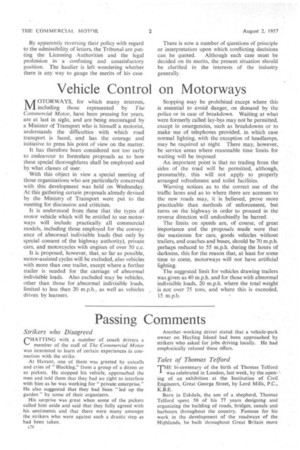Vehicle Control on Motorways
Page 28

If you've noticed an error in this article please click here to report it so we can fix it.
OTOR WAYS, for which many interests, including those represented by The Commercial Motor, have been pressing for years, are at last in sight, and are being encouraged by a Minister of Transport who is himself a motorist, understands the difficulties with which road transport is faced, and has the courage and initiative to press his point of view on the matter.
It has therefore been considered not too early to endeavour to formulate proposals as to how these special thoroughfares shall be employed and by what classes of user.
With this object in view a special meeting of those organizations who are particularly concerned with this development was held on Wednesday. At this gathering certain proposals already devised by the Ministry of Transport were put to the meeting for discussion and criticism.
It is understood from these that the types of motor vehicle which will be entitled to use motorways will include practically all commercial models, including those employed for the conveyance of abnormal indivisible loads (but only by special consent of the highway authority), private cars, and motorcycles with engines of over 50 c.c.
It is proposed, however, that, so far as possible, motor-assisted cycles will be excluded, also vehicles with more than one trailer, except where a further trailer is needed for the carriage of abnormal indivisible loads. Also excluded may be vehicles, other than those for abnormal indivisible loads, limited to less than 20 m.p.h., as well as vehicles driven by learners. Stopping may be prohibited except where this is essential to avoid danger, on demand by the police or in case of breakdown. Waiting at what were formerly called lay-bys may not be permitted, except in emergencies, such as breakdowns or to make use of telephones provided, in which case normal lighting, with the exception of headlamps, may be required at night. There may, however, be service areas where reasonable time limits for waiting will be imposed.
An important point is that no trading from the sides of the road will be permitted, although, presumably, this will not apply to properly arranged refreshment and toilet facilities.
Warning notices as to the correct use of the traffic lanes and as to where there are accesses to the new roads may, it is believed, prove more practicable than methods of enforcement, but turns on the highway in order to proceed in the reverse direction will undoubtedly be barred. , The limits on speeds are, of course, of great importance and the proposals made were that the maximum for cars, goods vehicles without trailers, and coaches and buses, should be 70 m.p.h. perhaps reduced to 55 m.p.h. during the hours of darkness, this for the reason that, at least for some time to come, motorways will not have artificial lighting.
The suggested limit for vehicles drawing trailers was given as 40 m.p.h. and for those with abnormal indivisible loads, 20 m.p.h. where the total weight is not over 75 tons, and where this is exceeded, 15 m.p.h.








































































































